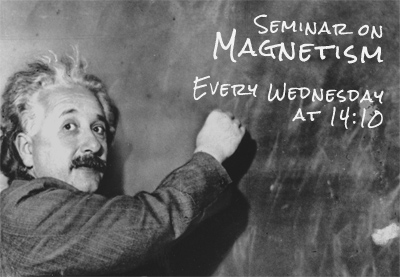Seminar on Magnetism
Group of Magnetism at the Department of Condensed Matter Physics
of Charles University and MGML has a pleasure to invite you to attend the joint seminar
on 9th April 2025 at 14:10
at Faculty of Mathematics and Physics of Charles University, Ke Karlovu 5, 121 16 Praha 2
Lecture room F2
Petr Doležal
DCMP, Faculty of Mathematics and Physics, Charles University, Ke Karlovu 5, 121 16 Prague 2
Magneto-elastic interaction in Y3Cu9(OH)19Cl8
Petr Doležal » Magneto-elastic interaction in Y3Cu9(OH)19Cl8
DCMP, Faculty of Mathematics and Physics, Charles University, Ke Karlovu 5, 121 16 Prague 2
joined X-ray and magnetic seminar
Online link: cesnet.zoom.us Ask R. Colman for password.
Location: Lecture room F2, first floor, MFF UK, Ke Karlovu 5
Quantum Spin Liquid (QSL) is a ground state of condensed matter, which is characterized by the absence of magnetic order down to the lowest temperatures along with long-range entanglement of fluctuating spin excitations [1]. Such a state of matter can be promoted by magnetic frustration which prevents the magnetic moments from antiferromagnetic ordering. There are many lattices created by magnetic ions exhibiting magnetic frustration. One of them is the two-dimensional kagome lattice with a high degree of frustration consisting of corner-sharing equilateral triangles. Although the concept is simple, finding such compounds with paramagnetic ions on a regular kagome lattice is quite complicated. The mineral herbertsmithite was considered as a very promising compound, but here the kagome lattice contains impurity spins created by the partial mixing of Zn and Cu atoms within and between the kagome planes. As a consequence, the magnetic properties at low temperatures are dominated by these impurities. Here we present the study of a related compound to herbertsmithite having a slightly distorted kagome lattice, but without impurity spins.
Y-kapellasite is yttrium copper hydroxychloride with the chemical formula Y3Cu9(OH)19Cl8, crystallizing in the rhombohedral crystal structure R-3 (148) [2]. The compound is antiferromagnetic below TN = 2.2 K [2]. An anomalous behavior was found in the temperature dependence of thermal expansion around 32 K, measured by dilatometry [3]. This finding rises the question whether there is any structural transition, but the X-ray and neutron diffraction experiments were inconclusive. We present the study of lattice dynamics studied by infrared spectroscopy. The obtained results are compared with the ab initio calculations and suggest the lowering of crystal lattice symmetry. The main crystal modification is probably caused by H atoms. We also observed the softening of low-energy phonons, which can be a sign of enhanced magnetoelastic interactions.
References
[1] L. Balents, ‘Spin liquids in frustrated magnets’, Nature, vol. 464, no. 7286. Springer Science and Business Media LLC, pp. 199–208, Mar. 10, 2010. doi: 10.1038/nature08917.
[2] P. Puphal, K. M. Zoch, J. Désor, M. Bolte, and C. Krellner, ‘Kagome quantum spin systems in the atacamite family’, Physical Review Materials, vol. 2, no. 6. American Physical Society (APS), Jun. 29, 2018. doi: 10.1103/physrevmaterials.2.063402.
[3] D. Chatterjee et al., ‘From spin liquid to magnetic ordering in the anisotropic kagome Y-kapellasite Y3Cu9(OH)19Cl8: A single-crystal study’, Physical Review B, vol. 107, no. 12. American Physical Society (APS), Mar. 28, 2023. doi: 10.1103/physrevb.107.125156


